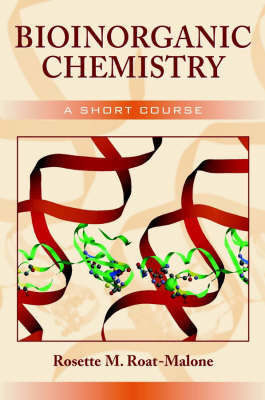
Bioinorganic Chemistry
John Wiley & Sons Inc (Verlag)
978-0-471-15976-6 (ISBN)
- Titel erscheint in neuer Auflage
- Artikel merken
Bioinorganic chemical knowledge grows more interesting and more complex with each passing year. As more details about the usage and utility of metals in biological species and more mechanistic and structural information about bioinorganic molecules becomes available, scientists and students continue to turn their attention to this blossoming discipline. Rosette Roat-Malone's Bioinorganic Chemistry: A Short Course provides an accessible survey of bioinorganic chemistry for advanced undergraduate and graduate students. Comprehensive coverage of several topics offers insight into the increasingly diverse bioinorganic area. Roat-Malone's text concentrates on bioinorganic chemistry's two major focuses: naturally occurring inorganic elements and their behavior in biological systems, and the introduction of inorganic elements into biological systems, often as medicines. The book begins with two review chapters, Inorganic Chemistry Essentials and Biochemistry Fundamentals. Chapter 3, Instrumental and Computer-Based Methods, provides an introduction to some important instrumental techniques, including basic information about computer hardware and software.
Chapters on specific topics include: * Iron Containing Oxygen Carriers and Their Synthetic Models * Copper Enzymes * The Enzyme Nitrogenase * Metals in Medicine The author also encourages instructors and students to pursue their own independent investigations in bioinorganic topics, providing a helpful, detailed list of suggestions. With a host of current bibliographic references, Bioinorganic Chemistry: A Short Course proves the premier text in its field.
ROSETTE M. ROAT-MALONE, PhD, is Professor of Chemistry at Washington College in Chestertown, Maryland. She received her doctorate in chemistry from the University of Delaware.
Preface.Acknowledgments.1 Inorganic Chemistry Essentials.1.1 Introduction.1.2 Essential Chemical Elements.1.3 Metals in Biological Systems: A Survey.1.4 Inorganic Chemistry Basics.1.5 Biological Metal Ion Complexation.1.5.1 Thermodynamics.1.5.2 Kinetics.1.6 Electronic and Geometric Structures of Metals in Biological Systems.1.7 Bioorganometallic Chemistry.1.8 Electron Transfer.1.9 Conclusions.References.2 Biochemistry Fundamentals.2.1 Introduction.2.2 Proteins.2.2.1 Amino Acid Building Blocks.2.2.2 Protein Structure.2.2.3 Protein Sequencing and Proteomics.2.2.4 Protein Function, Enzymes, and Enzyme Kinetics.2.3 Nucleic Acids.2.3.1 DNA and RNA Building Blocks.2.3.2 DNA and RNA Molecular Structures.2.3.3 Transmission of Genetic Information.2.3.4 Genetic Mutations and Site-Directed Mutagenesis.2.3.5 Genes and Cloning.2.3.6 Genomics and the Human Genome.2.4 Zinc-Finger Proteins.2.4.1 Descriptive Examples.2.5 Conclusions.References.3 Instrumental and Computer-Based Methods.3.1 Introduction.3.1.1 Analytical Instrument-Based Methods.3.1.2 Spectroscopy.3.2 X-Ray Absorption Spectroscopy (XAS) and Extended X-Ray Absorption Fine Structure (EXAFS).3.2.1 Theoretical Aspects and Hardware.3.2.2 Descriptive Examples.3.3 X-Ray Crystallography.3.3.1 Introduction.3.3.2 Crystallization and Crystal Habits.3.3.3 Theory and Hardware.3.3.4 Descriptive Examples.3.4 Electron Paramagnetic Resonance.3.4.1 Theory and Determination of g-Values.3.4.2 Hyperfine and Superhyperfine Interactions.3.4.3 Descriptive Examples.3.5 Nuclear Magnetic Resonance.3.5.1 Theoretical Aspects.3.5.2 Nuclear Screening and the Chemical Shift.3.5.3 Spin-Spin Coupling.3.5.4 Techniques of Spectral Integration and Spin-Spin Decoupling.3.5.5 Nuclear Magnetic Relaxation.3.5.6 The Nuclear Overhauser Effect (NOE).3.5.7 Obtaining the NMR Spectrum.3.5.8 Two-Dimensional (2D) NMR Spectroscopy.3.5.9 Two-Dimensional Correlation Spectroscopy (COSY).3.5.10 Nuclear Overhauser Effect Spectroscopy (NOESY).3.5.11 Descriptive Examples.3.6 Mo ssbauer Spectroscopy.3.6.1 Theoretical Aspects.3.6.2 Quadrupole Splitting and the Isomer Shift.3.6.3 Magnetic Hyperfine Interactions.3.6.4 Descriptive Examples.3.7 Other Instrumental Methods.3.7.1 Atomic Force Microscopy.3.7.2 Fast and Time-Resolved Methods.3.7.2.1 Stopped-Flow Kinetic Methods.3.7.2.2 Flash Photolysis.3.7.2.3 Time-Resolved Crystallography.3.8 Introduction to Computer-Based Methods.3.9 Computer Hardware.3.10 Molecular Modeling and Molecular Mechanics.3.10.1 Introduction to MM.3.10.2 Molecular Modeling, Molecular Mechanics, and Molecular Dynamics.3.10.3 Biomolecule Modeling.3.10.4 Molecular Modeling Descriptive Examples.3.11 Quantum Mechanics-Based Computational Methods.3.11.1 Introduction.3.11.2 Ab-Initio Methods.3.11.3 Density Function Theory.3.11.4 Semiempirical Methods.3.12 Computer Software for Chemistry.3.12.1 Mathematical Software.3.13 World Wide Web Online Resources.3.13.1 Nomenclature and Visualization Resources.3.13.2 Online Societies, Literature, Materials, Equipment Web Servers.3.14 Summary and Conclusions.References.4 Iron-Containing Oxygen Carriers and Their Synthetic Models.4.1 Introduction.4.2 Myoglobin and Hemoglobin Basics.4.3 Structure of the Prosthetic Group.4.4 Analytical Techniques.4.5 Mechanism for Reversible Binding of Dioxygen and Cooperativity of Oxygen Binding.4.6 Behavior of Dioxygen Bound to Metals.4.7 Structure of the Active Site in Myoglobin and Hemoglobin: Comparison to Model Compounds.4.8 Model Compounds.4.8.1 Cobalt-Containing Model Compounds.4.8.2 Iron-Containing Model Compounds.4.9 Binding of CO to Myoglobin, Hemoglobin, and Model Compounds.4.10 Conclusions.References.5 Copper Enzymes.5.1 Introduction, Occurrence, Structure, Function.5.2 Discussion of Specific Enzymes.5.2.1 Azurin.5.2.2 Plastocyanin.5.2.3 Superoxide Dismutase.5.2.4 Hemocyanin.5.3 Model Compounds.5.3.1 Introduction.5.3.2 Type I Copper Enzyme Models.5.3.3 Type II Copper Enzyme Models.5.3.4 Type III Copper Enzyme Models.5.3.4.1 Karlin Group Tridentate Model Compounds.5.3.4.2 Tolman Group Tetradentate Model Compounds.5.3.4.3 Kitajima Group Tetradentate Model Compounds.5.3.4.4 Karlin Group Tetradentate Model Compounds.5.3.5 Summary.5.4 Conclusions.References.6 The Enzyme Nitrogenase.6.1 Introduction.6.2 Detailed Mechanistic Studies.6.3 Iron-Sulfur Clusters.6.4 Fe-Protein Structure.6.5 MoFe-Protein Structure.6.5.1 Overview.6.5.2 Details of the P-Cluster.6.5.3 Details of the M Center.6.6 Nitrogenase Model Compounds.6.6.1 Structural Models.6.6.2 Functional Models.6.7 Conclusions.References.7 Metals in Medicine.7.1 Introduction.7.1.1 Inorganic Medicinal Chemistry.7.1.2 Metal Toxicity and Homeostasis.7.2 Therapeutic Compounds.7.2.1 Superoxide Dismutase Mimics.7.2.2 Vanadium-Based Diabetes Drugs.7.2.2.1 Introduction.7.2.2.2 Examples of Vanadium Compounds Tested as Insulin Mimetic Agents.7.2.2.3 The Role of Chromium.7.2.3 Platinum-Containing Anticancer Agents.7.2.3.1 Cis- and trans-Dichlorodiammineplatinum(II).7.2.3.2 Mechanism of cisDDP Antitumor Activity.7.2.3.3 Drug Resistance and DNA Repair Mechanisms.7.2.3.4 A New Nonclassical Platinum Antitumor Agent.7.2.3.5 Other Platinum-Containing Anticancer Compounds.7.2.3.6 Conclusions.7.3 Diagnostic Agents.7.3.1 Technetium Imaging Agents.7.3.1.1 Introduction.7.3.1.2 "Technetium Essential" Radiopharmaceuticals.7.3.1.3 "Technetium Tagged" Radiopharmaceuticals.7.3.2 Gadolinium MRI Imaging Agents.7.3.2.1 Introduction.7.3.2.2 Magnetic Imaging Considerations, Kinetics, and Thermodynamics of Complexes.7.3.2.3 Selected Drugs in Usage or in Trials.7.4 Metal Transport and Metallochaperones.7.4.1 Introduction.7.4.2 The Atx1 Metallochaperone.7.4.3 Hah1 or Atox1 Metallochaperone.7.4.4 Superoxide Dismutase Metallochaperones.7.4.5 Copper Toxicity, Disease States, and Treatments.7.4.5.1 Familial Amyotrophic Lateral Sclerosis (FALS).7.4.5.2 Wilson and Menkes Diseases.7.4.6 Conclusions.7.5 Metals in Medicine (MIM).7.5.1 Summary, Goals; Past, Present, and Future MIM Development.References.Index.
| Erscheint lt. Verlag | 18.10.2002 |
|---|---|
| Zusatzinfo | Illustrations |
| Verlagsort | New York |
| Sprache | englisch |
| Maße | 154 x 239 mm |
| Gewicht | 539 g |
| Einbandart | Paperback |
| Themenwelt | Naturwissenschaften ► Biologie ► Biochemie |
| Naturwissenschaften ► Chemie ► Anorganische Chemie | |
| ISBN-10 | 0-471-15976-X / 047115976X |
| ISBN-13 | 978-0-471-15976-6 / 9780471159766 |
| Zustand | Neuware |
| Informationen gemäß Produktsicherheitsverordnung (GPSR) | |
| Haben Sie eine Frage zum Produkt? |
aus dem Bereich



